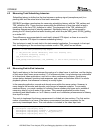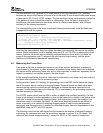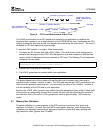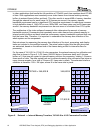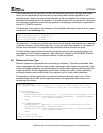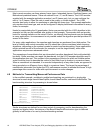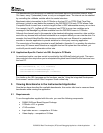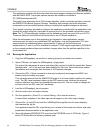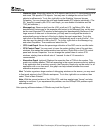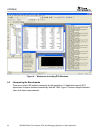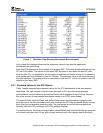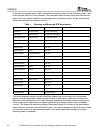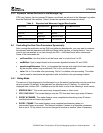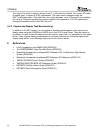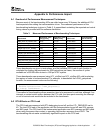
SPRAA56
20 DSP/BIOS Real-Time Analysis (RTA) and Debugging Applied to a Video Application
The application supplied with this note references board support software and libraries installed
with the DM642 EVM. The project options assume this software is installed in
$TI_DIR$\boards\evmdm642.
The project also references the H.263 encoder algorithm, which is provided as object code with
the DM642 EVM’s Board Support Package. Therefore, that package and all its associated
components must be installed before running or building the supplied example as delivered.
Tconf scripts have been provided to configure the application provided with this application note.
A batch file (makeConfig.bat) is provided to execute tconf on the provided configuration script.
Note: The TI_DIR environment variable must be defined and tconf.exe must be in your PATH.
These are defined in the DosRun.bat file provided in the CCStudio installation.
While the techniques used in this application are targeted at video applications, several
techniques can be used in any embedded DSP application, such as programmatic CPU load
measurement and scheduling latency measurement. Further, all the techniques are
implemented in C code or in APIs available for multiple TI DSP targets supported by DSP/BIOS,
so the concepts presented here are portable to targets other than the platform specified in the
requirements list.
5.2 Running the Application
1. Copy the h263loopback_rta.zip file to a working directory and extract its contents.
2. Open CCStudio, and open the h263loopback_rta.pjt project.
The project file references all source and object files required to build the executable. Source
filenames with “_rta” at the end have been modified for this note. Source filenames without
that addition are unchanged from the base H.263 loopback example.
3. Choose the GEL
→
Reset command to clear any breakpoints and prepare the EMIF and
memory map for loading a program.
This command ensures that the DM642 EVM target is in a known stable condition for loading
code. The GEL reset command clears up the DSP memory map, initializes the external
memory interface, and clears any breakpoints previously set. You can review or change the
source code for the GEL reset file if necessary.
4. Load the h263loopback_rta.out program.
5. Start the video input and output devices.
6. Run the application. (Press F5, or choose Debug
→
Run from the menus.)
A looped back redisplay of the video input should appear on the video output display.
7. Choose File
→
Load GEL and load the h263RateControl.gel file from the same directory
that contains the .pjt file.
This application-specific GEL script allows you to control of the frame rate, bitrate, and other
parameters discussed earlier in this application note.
8. Open the following DSP/BIOS RTA tools from the DSP/BIOS menu in CCStudio. Figure 6
shows CCStudio with the following windows open.



